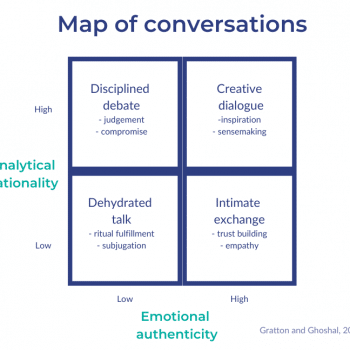Does your team have conversations that get results? Or do they have a lot of discussions?
You know, the ones where they talk and try to influence each other why they are right.
Would you rather your team build upon, instead of shutting down ideas?
What you choose to do as a leader can have a significant impact.
In their 2002 article Improving the Quality of Conversations Lynda Gratton and Sumantra Ghoshal mapped conversations across four quadrants:
Where on the map is the bulk of your conversation?
Are they where you want them to be?
Does your team follow the same set of rules and end up debating everything discussed?
Disciplined debate might be appropriate when you are checking compliance requirements. However, it can stifle creativity if you are exploring a complex issue or a possible innovation.
Talk may be dehydrated if people feel it is pointless sharing their ideas or feelings when meeting agendas do not allow sufficient time for genuine dialogue. People could be afraid of sharing their feelings if conversations are overly facts-based, and emotion is discouraged.
Çreative dialogue happens when thinking and feeling come together in creative, insightful and energising conversations. Precisely what is needed when a team or group of stakeholders has to manage volatility, uncertainty, complexity or ambiguity (VUCA).
It takes effort and a willingness to experiment to find that conversation sweet spot.
No one wants to spend their time in dehydrated conversations, but the other conversations on the map all have a place. The trick is to create the conditions for the right kind of exchange for the context.
This is the first in a series of three articles sharing some practical strategies you can use to improve stakeholder and your team’s conversations.
First, suspend judgement and listen to learn.
Start by helping others suspend judgement and listen to learn.
Suspending judgement means waiting to decide until you know more about the topic or situation. It means choosing to put aside your convictions and beliefs for now, consciously.
When you listen to learn, you hold yourself back from jumping in with your ideas about fixing the problem. You also avoid expressing yourself in a way that discourages other people from sharing their views.
Encourage curiosity, so the conversation is more in-depth and explores what is going on underneath the surface talk. Try responding to what someone says with ‘I am curious [about why/to understand]’.
Instead of focusing on what the person’s message means to you, focus on what it might mean to them.
 The most effective listeners are not silent listeners.
The most effective listeners are not silent listeners.
In ‘What Great Listeners Actually Do’ Jack Zenger and Joseph Folkman explain good listening is a two-way dialogue. One where the listener periodically asks questions that can lead to discovery and insight.
Research also found good listening happened when the listener ‘made the other person feel supported and conveyed confidence in them’.
Good listening happened when conversation flowed smoothly between people, and no one was defensive or competitive.
Challenging and disagreeing was okay as long as others felt this would help and not win an argument.
Making suggestions was also okay if they opened up alternative paths for consideration. However, suggestions were better coming from someone with credibility as a listener.
Support your team to test their assumptions
Do you ever find yourself quickly jumping to a conclusion based on apparent similarities between situations?
You know, it looks like a duck, sounds like a duck, so it must be a duck. However, when you dig a little deeper, you discover it is something completely different.
Help your team avoid identifying too many false ducks by asking:
‘I wonder what else could be going on?’
‘Why do we think that?’
‘[What do you think/Do we know] what XXXX [thinks/feels]?’
Create the expectation a diversity of perspectives will be explored
In Simple Habits for Complex Times, Jennifer Garvey-Berger and Keith Johnston emphasise the value of learning through seeking out multiple perspectives.
 These different perspectives are needed to build bridges to new places.
These different perspectives are needed to build bridges to new places.
Garvey-Berger and Johnston say ‘until you know how others see the world, you’ll have little opportunity to influence or learn from their perspectives’.
Multiple perspectives are central bridge-building tools. Think of them as the foundations you have to have. Your bridge may fall over if they are missing.
Ensure exploration of perspectives is part of your conversational culture.
Conversations that deal with both ideas and feelings are valued
If rationality is about using a structured approach to find an answer to your problem, emotions are about finding the meaning.
When someone suggests a course of action, confidently ask your team how they feel about it. Dig deeper and ask why, if it is not clear at first. Doing so will either generate a commitment to the action or identify issues that need to be explored before deciding on a course of action.
Working out what to do next with your problem, is useless if no one is committed to, or has the energy to support implementation. However, it often takes time, trust or someone who can challenge people with sensitivity to create a safe space for this kind of conversation.
More on this in part two.
Start putting it into practice
Which are the concepts here that most resonated with you?
Is there one that would make a big difference to the quality of your conversations?
If so, pick a situation where it is safe to experiment. Be brave and share with others what you want to experiment with and why.
Afterwards, invite their feedback. Keep experimenting and tweaking, until you are confident using the technique in more critical situations.
Share this article and ask for other people’s perspective on what would make the most difference to your conversations.
And, if you need a hand along the way, reach out, and we can explore how I could help. You can find out more about me at Leadership Coach in Brisbane, QLD | Susanne Le Boutillier
Look out for part two and part three in this series so you can improve the quality of your conversations and get better results.
If you want to boost your team’s performance, you can also join my mailing list to access the free download Five Powerful Strategies to Unleash an Unstoppable Team.



 The most effective listeners are not silent listeners.
The most effective listeners are not silent listeners. These different perspectives are needed to build bridges to new places.
These different perspectives are needed to build bridges to new places.



